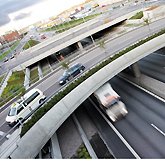Of road networks and travel patterns

The collapse of the I-35W bridge during rush hour on August 1, 2007 sparked a number of new research studies by structural engineers to understand the causes of the catastrophe. At the same time, transportation researchers realized that the tragic event had provided them with a rare opportunity to study how metropolitan drivers respond to the sudden loss of a major transportation link. About 140,000 cars crossed the I-35 bridge daily before the collapse.
Analyzing the ways transportation networks or traffic flow patterns change over time is a specialty of the University of Minnesota's Networks, Economics and Urban Systems (NEXUS) research group, headed by David Levinson, the U's Richard P. Braun-CTS Chair in Transportation Studies. In the weeks immediately following the collapse, Levinson worked with the University of Minnesota's Department of Civil Engineering and several other transportation experts, including U colleagues Henry Liu, Nikolas Geroliminis, and Kathleen Harder, to gather traffic data, perform a preliminary analysis, and identify further research needs The study ("The traffic and behavioral effects of the I-35W Mississippi River bridge collapse" PDF download) found that traffic adapted well to the bridge collapse, and though most drivers did not see a change in travel time when they found alternative routes for their trips, some saw an increase and a smaller number experienced a reduction in their travel time. Of the 140,000 vehicles crossing the bridge prior to the collapse, only 90,000 could be accounted for after the incident because of increased traffic on the other bridges. (The number of vehicles crossing the I-94 Mississippi River bridge, for example, jumped 26 percent during that time.) This finding suggested that the remaining 50,000 cars had avoided crossing the river--either not making the trip at all, or more likely, changing destinations. (Highway 280, the primary detour recommended by the Minnesota Department of Transportation, saw an increase in daily traffic on both directions from 25,000 trips that August to about 64,000 in October). The results of the study led to two additional studies on the effects of the collapse. Mn/DOT funded the first, "Traffic Flow and Road User Impacts of the Collapse of the I-35W Bridge over the Mississippi River," with the goal of understanding the effect of the bridge closure on observed travel behavior, shifts in traffic flows, and alternate routes. The researchers are developing a model of local travel behavior prior to and following the collapse with data from travel surveys, as well as GPS tracking of study participants whose activities are affected by the loss of the bridge. Using these models and observations of travel pattern changes, the researchers will attempt to estimate road-user costs associated with the collapse. Complementing the Mn/DOT study is "BRIDGE: Behavioral Response to the I-35W Disruption: Gauging Equilibration," which is funded by the National Science Foundation with additional support from the University of Minnesota's Metropolitan Consortium. This study aims to better understand how an extensive traffic system responds to a sudden, major network disruption. Following a serious disruption, the researchers theorize, the Twin Cities surface transportation system is likely to settle into a new state of equilibrium as thousands of users adapt their behavior to the new demands of getting from place to place. On the other hand, the possibility that the system will remain chaotic for a long time cannot be ruled out without gathering detailed data. Both projects are expected to be completed in 2010. The NEXUS group members have already completed several scholarly papers on the effects of the bridge collapse, which are available on the Internet, along with more information about the research projects and related transportation issues.
